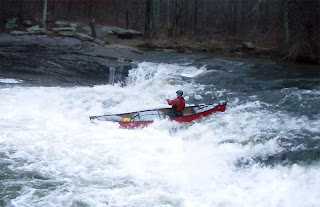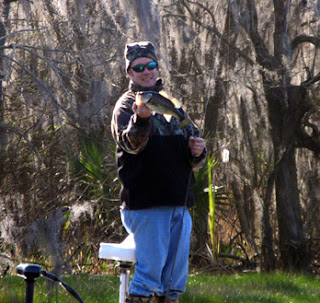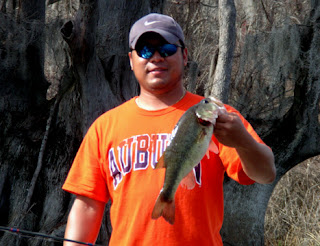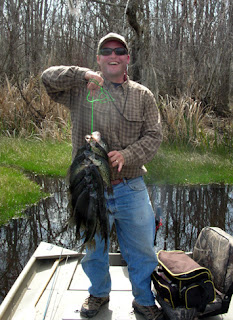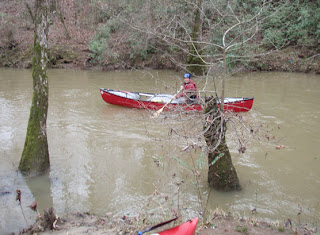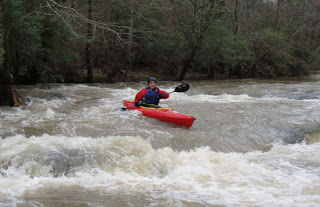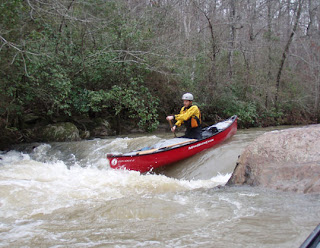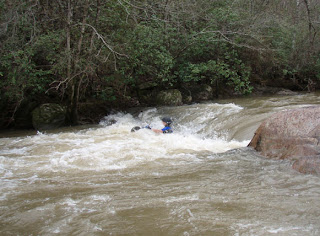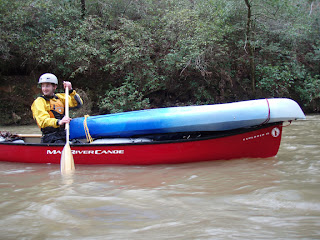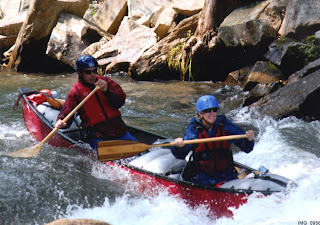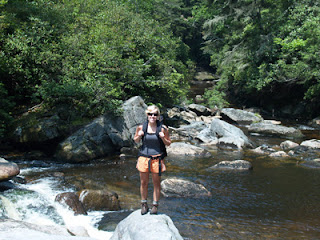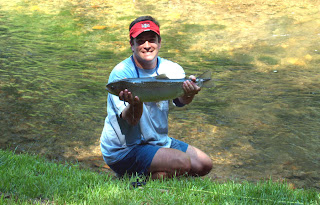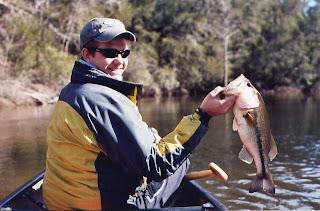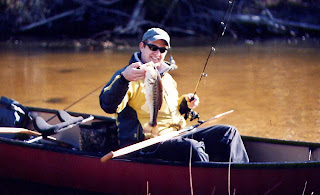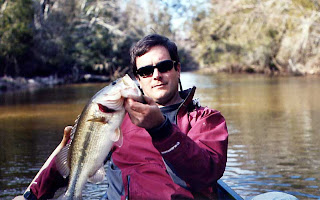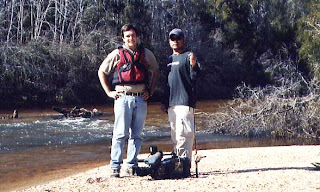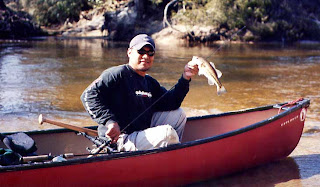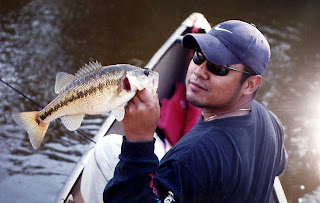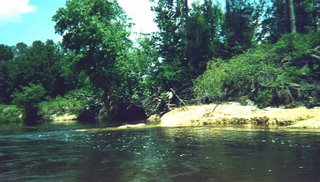Swamp Creek
Swamp Creek is a
headwater stream with a short watershed located in southern
Coosa County, AL. It doesn't look like much of a run from the road access points at US 231 and
HW 22. However, this stream offers one the most challenging stretch of rapids this far south in the central part of Alabama. There are two other shorter runs in the area that have good drops too,
Weoka and
Socapatoy Creeks, that we hope to paddle another time.
Swamp Creek is not as consistent as Hatchet Creek in its shoals and drops, but its definitely more challenging in places. It does have two short sections of surprising gradient, with rapids that approach Class III in the upper section. This bi-polar creek begins with a long stretch of
flatwater, followed by an intense sections of drops and falls.
The scenery is pretty decent during the sections of increased gradient. Rock banks bend and twist among mountain laurels and hardwoods. There is very little sign of civilization. You will pass the occasional deer stand or small camp along the way.
The clarity of this stream is poor when water levels are high enough to run. The
streambed is also choked with sediment in the flat sections, due to clear cut logging along its drainage. It is also prone to logjams in places. The fishing might be decent if you wade it during low water periods. It is silted in pretty good and I bet snakes are a problem in the summer. Watch for red Mad River Explorer paint on some of the rocks at lower water.

You need to catch this small creek right after significant rains.
Alabama whitewater lists the minimum for the stream at 700
cfs on the Hatchet Creek gauge. I wouldn't try it any lower than 1000
cfs, and make sure the Hatchet level is steady or rising when you put in. Hatchet Creek's watershed is a good bit north of Swamp Creek. So, it would be a great idea to check out the latest storm total precipitation levels from the
Birmingham Radar site. You need 2-3" of very recent rain on top of a decent base flow.
Trip Report
Level: Too Low
Flow: 950, falling to 700
Gauge: Hatchet Creek
Clarity: Stained/Muddy
Weather: Mid 50's - Cloudy skies
Section: US 231 to Kelly Crossroads Bridge
Upper Swamp
The Hatchet level peaked at 1,200
cfs at 8am Sunday, April 15 as we drove up to
Coosa County from Mobile. We were optimistic about the run of Swamp Creek, which has listed minimum of 700
cfs. Unfortunately, the low water table and short watershed didn't work in our favor. The Hatchet gauge fell to 950
cfs by the time I had biked the 13 mile shuttle. Curtis noticed the visual level on Swamp had dropped 2-3" in an hour or so while he got the boats loaded out with floatation. Little did we know that the Hatchet level would fall to 700
cfs. Swamp was probably down to a mere 100
cfs or so by the end of the day.
Swamp Creek starts out flat, with a shallow silted bottom. Several tributaries join the flow along river right and add some volume. The first signs of gradient appear about 2-3 miles into the run. Swamp goes abruptly from virtual
flatwater, to significant rapids and drops. The first real good rapid is a
boarderline class III drop of about 6'. After scraping through some of the initial shoals, there was good reason to hope for decent day after running the six foot falls. Curtis ran it first with no trouble. I ran it too - clean -with no scraping.
The next class II drop of about 4-5 feet was not runnable as the river became wider. The shoals were also rocky and troublesome. There is a small dam in the midst of the whitewater, but its easily portaged on the right side. We did technically run the double drop below the dam. This is definitely class III with some decent water. Both Curtis and I survived the double drop, only to get hung up on the rocks at the base of the rapid. After a good stretch of rapids that lasted for about 2 miles, the gradient ended and we paddled out through logjams strewn along the
streambed for the remaining 2-3 miles. A tornado must have gone through the day before just above the CR 22 bridge. A dozen large trees with fresh leaves lay in the
streambed. All in all we dealt with 10-15 logjams that required some significant
maneuvering. At this level, we were able to squeeze over and around most of them. Higher levels would get you over some logs more easily, but the strainer danger would be higher too. Be careful.
Lower Swamp - 3 miles
We paddled both sections for a combined 11 miles of dragging and dodging rocks in low water...
Lower Swamp is an easy, short run that also starts out very flat. I did not scout the access point at the
HW 22 bridge as we paddled past it... But, reports are that you can find decent parking and access. The gradient picks up a good bit in the
sedcond half of the run. You will find a number of ledges and
smnall drops. The drops on the Lower Swamp are not as challenging as the two decent class II+ drops in the upper Hatchet (280-231) run. This is also a much easier run than the Upper Swamp.
It also widens out quite a bit in places, yet has a much smaller drainage than Hatchet. The result is that you need a lot of water. I would recommend at least 1,000
cfs on the Hatchet
Guage and/or recent significant rain to enjoy this section. I wouldn't float this section again unless:
#1 I had a lot of water - 1500
cfs+ on Hatchet
#2 I was in the area and short on time
#3 I had beginner paddlers and was/or floated it tandem




